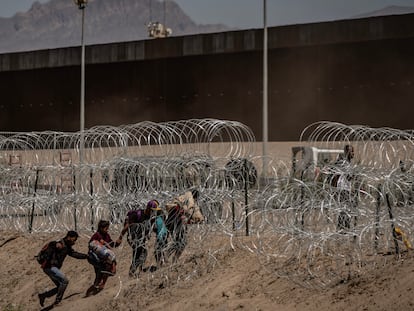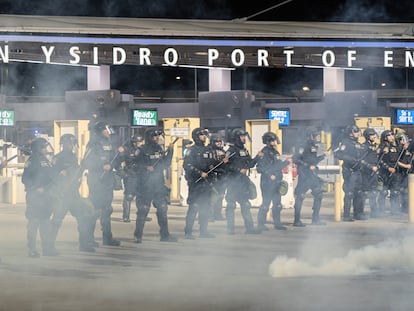Migrants in Tijuana unmoved by end of Title 42
In the Mexican city, located on the border with the United States, most continue to wait for an asylum-request appointment, rather than crossing illegally
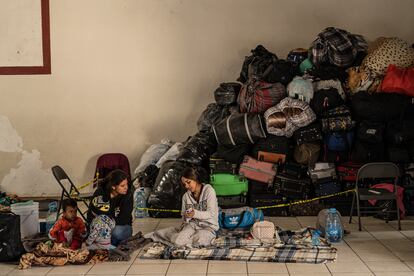

The end of Title 42 hasn’t had a drastic effect on the mood in Tijuana. On Thursday morning, just hours before the expiry of the measure, which allowed the United States to quickly turn away migrants illegally entering the country, things remained calm in the city, which is located on Mexico’s border with the U.S. Only a few hundred people had set up camp between the two border walls, as they prepared to hand themselves over to the American authorities. Meanwhile, thousands waited patiently in the city’s migrant shelters, cell phones in hand, hoping to secure an appointment on CBP One, the U.S.’s asylum-request app. In Tijuana, it is smartphones — not the border wall — that are at the center of people’s battle to make it into the States.
At 9 a.m., with breakfast still out on the tables at the Juventud 2000 shelter in downtown Tijuana, Yineysi Olalde held her head in her hands. The 34-year-old Cuban was cursing herself for the slip of the thumb that had led her to accidentally close the CBP One app, in the process losing her place in the virtual line to seek asylum in the U.S. Other migrants consoled her: as has been the case every day since January, there’ll be another chance tomorrow. Olalde arrived in Tijuana a month ago. She left Havana in December, before traveling through Central America and spending three months waiting in Tapachula, on the southern Mexican border, where she was given a 12-month permit to cross Mexico. That’s her deadline to reach the U.S.; if she doesn’t manage it by the time her year is up, Olalde plans to seek asylum in Mexico. “I’m not going across the border illegally,” she declares. The end of Title 42 makes no difference to her: “I’m not going to risk it.”
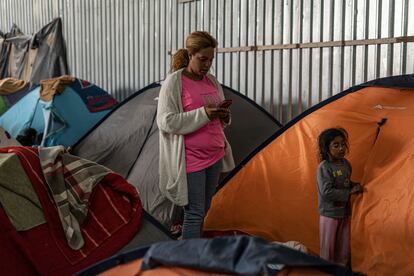
This attitude has become the norm in Tijuana. The information drives carried out by the city’s major shelters have served to curb the atmosphere of desperation among migrants, who are waiting calmly for the U.S. authorities to give them an appointment. The Baja California government says the increased flow of people in recent days has led the state’s 42 migrant shelters to fill up, so two more are going to be opened in Tijuana. Gustavo Banda, the director of the Embajadores de Jesús shelter, the largest on Mexico’s northern border, says efforts to provide migrants with the right information have had a “crucial” effect. “It’s because of this that migrants are keeping their cool here,” Banda explains. “For them, nothing has changed with the expiry of Title 42. It’s down to the proper information that they’re getting that they’re not trying to enter unlawfully and risking deportation to their home country.”
José María García Lara, the director of the Juventud 2000 shelter, agrees. “We urge migrants to wait to enter the U.S. legally, by following the correct procedure,” García Lara says. “We tell them not to place themselves and their families in danger by risking it, because they could slip into the wrong hands and fall prey to misinformation. And, for now, people are staying calm.”
The situation in Tijuana is very different to the images emerging from Ciudad Juárez, where migrant detentions have multiplied in recent days, while thousands of others have been waiting for the expiry of Title 42 to cross the border and turn themselves in. “Misinformation remains a hugely significant problem here,” says Rodolfo Cruz Piñeiro, a migration analyst at Tijuana’s Colegio de la Frontera Norte, an institute that specializes in research on border issues. “Immigrants should be in no doubt about this: the United States isn’t opening its border. What’s more, with the transition to Title 8, the consequences of deportation after crossing unlawfully are heavier.”
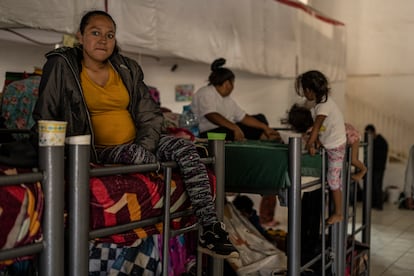
Following the end of Title 42 on Thursday night, illegal migrants deported from the U.S. will be ejected under Title 8, an immigration measure that carries a stiff penalty: they will be barred from re-entry into the U.S. for five years. They will be returned to their home countries, unless they are from Cuba, Haiti, Nicaragua or Venezuela. Citizens of these nations will serve their five-year bans in Mexico, after U.S. President Joe Biden and his Mexican counterpart, Andrés Manuel López Obrador, agreed that they can be deported across America’s southern border. It’s a deal that promises to make Mexico a perennial waiting room for such migrants.
Every day before 8 a.m., thousands of people in Mexico City, Guadalajara and along the border area try their luck on the U.S.’s overwhelmed asylum-request app, which is currently handing out a few hundred appointments a day — albeit President Biden’s administration has committed to raising that number to 1,000. Some people have been waiting for months for the app to give them their opportunity.
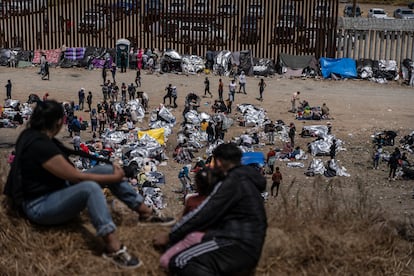
Diana Álvarez and her family, who have traveled from Honduras, still haven’t managed to get an appointment. They’ve been in Tijuana for eight months, with no progress since then. “The wait is really hard,” says Álvarez, 29, who fled Honduras over threats from gangs. “We’ve even started thinking about crossing the border illegally, but we’ve been advised against it.” Óscar Díaz and his mother, Catalina Palencia, departed Guatemala for the same reason as Álvarez. “We had a taxi company, but we were being extorted to such a degree that we couldn’t pay up anymore,” says Palencia, 57, who is accompanied by her two granddaughters. “We left before they killed us.” After nine months in Tijuana, they’ve secured an appointment to seek asylum in the U.S. on 20 May.
CBP One has become a virtual border wall that stops migrants from crossing illegally into the U.S. However, Inés Barrios, a researcher at the Colegio de la Frontera Norte, warns: “Getting an appointment doesn’t guarantee that you’re going to be granted residency. In fact, what we’ve seen is that the amount of successful asylum requests is very low. We’ve broken down the numbers by nationality: for Guatemalans, Hondurans and Salvadorans, for example, the success rate is just 6%. In other words, for every 100 people that go through the process, only six are granted residency.”
Sign up for our weekly newsletter to get more English-language news coverage from EL PAÍS USA Edition
Tu suscripción se está usando en otro dispositivo
¿Quieres añadir otro usuario a tu suscripción?
Si continúas leyendo en este dispositivo, no se podrá leer en el otro.
FlechaTu suscripción se está usando en otro dispositivo y solo puedes acceder a EL PAÍS desde un dispositivo a la vez.
Si quieres compartir tu cuenta, cambia tu suscripción a la modalidad Premium, así podrás añadir otro usuario. Cada uno accederá con su propia cuenta de email, lo que os permitirá personalizar vuestra experiencia en EL PAÍS.
¿Tienes una suscripción de empresa? Accede aquí para contratar más cuentas.
En el caso de no saber quién está usando tu cuenta, te recomendamos cambiar tu contraseña aquí.
Si decides continuar compartiendo tu cuenta, este mensaje se mostrará en tu dispositivo y en el de la otra persona que está usando tu cuenta de forma indefinida, afectando a tu experiencia de lectura. Puedes consultar aquí los términos y condiciones de la suscripción digital.
More information
Últimas noticias
Raúl Rocha, from jet-setting with Miss Universe to arms trafficking and fuel theft
80,000 barrels of Mexican oil sent to Cuba: Havana drawn into the US–Mexico clash
Human rights activists, opposition members, and a minor: Maduro’s other political prisoners
Israel sparks a civil war within the MAGA movement
Most viewed
- Reinhard Genzel, Nobel laureate in physics: ‘One-minute videos will never give you the truth’
- Pablo Escobar’s hippos: A serious environmental problem, 40 years on
- Charles Dubouloz, mountaineering star, retires at 36 with a farewell tour inspired by Walter Bonatti
- Why we lost the habit of sleeping in two segments and how that changed our sense of time
- The fall of a prolific science journal exposes the billion-dollar profits of scientific publishing
